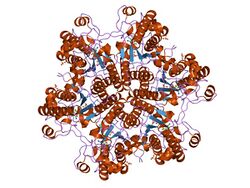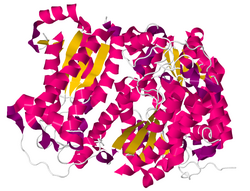Biology:Creatininase
| Creatininase | |||||||||
|---|---|---|---|---|---|---|---|---|---|
 creatininase-product complex | |||||||||
| Identifiers | |||||||||
| Symbol | Creatininase | ||||||||
| Pfam | PF02633 | ||||||||
| InterPro | IPR003785 | ||||||||
| SCOP2 | 1v7z / SCOPe / SUPFAM | ||||||||
| |||||||||
In enzymology, a creatininase (EC 3.5.2.10) is an enzyme that catalyses the hydrolysis of creatinine to creatine, which can then be metabolised to urea and sarcosine by creatinase.
- creatinine + H2O [math]\displaystyle{ \rightleftharpoons }[/math] creatine
Thus, the two substrates of this enzyme are creatinine and H2O, whereas its product is creatine.
Creatininase is a member of the urease-related amidohydrolases,[2] the family of hydrolases, those acting on carbon-nitrogen bonds other than peptide bonds, specifically in cyclic amides. The systematic name of this enzyme class is creatinine amidohydrolase. This enzyme is also called creatinine hydrolase. This enzyme participates in arginine and proline metabolism.
Structural studies
Creatininase from Pseudomonas putida has a core structure consisting of 3-layers, alpha/beta/alpha.[3]
As of late 2007, 4 structures have been solved for this class of enzymes, with PDB accession codes 1J2T, 1J2U, 1Q3K, and 1V7Z.
References
- ↑ PDB: 3NO4; Joint Center for Structural Genomics (2010). Crystal structure of a creatinine amidohydrolase (Npun_F1913) from Nostoc punctiforme PCC 73102 at 2.00 A resolution. doi:10.2210/pdb3no4/pdb.
- ↑ "Cloning of the creatinine amidohydrolase gene from Pseudomonas sp. PS-7". Biosci. Biotechnol. Biochem. 59 (7): 1331–1332. 1995. doi:10.1271/bbb.59.1331. PMID 7670196.
- ↑ "Crystal structures of creatininase reveal the substrate binding site and provide an insight into the catalytic mechanism". J. Mol. Biol. 337 (2): 399–416. March 2004. doi:10.1016/j.jmb.2004.01.022. PMID 15003455.
- "Creatinine decomposing enzymes in Pseudomonas putida". Agric. Biol. Chem. 40 (5): 1011–1018. 1976. doi:10.1271/bbb1961.40.1011.
 |


